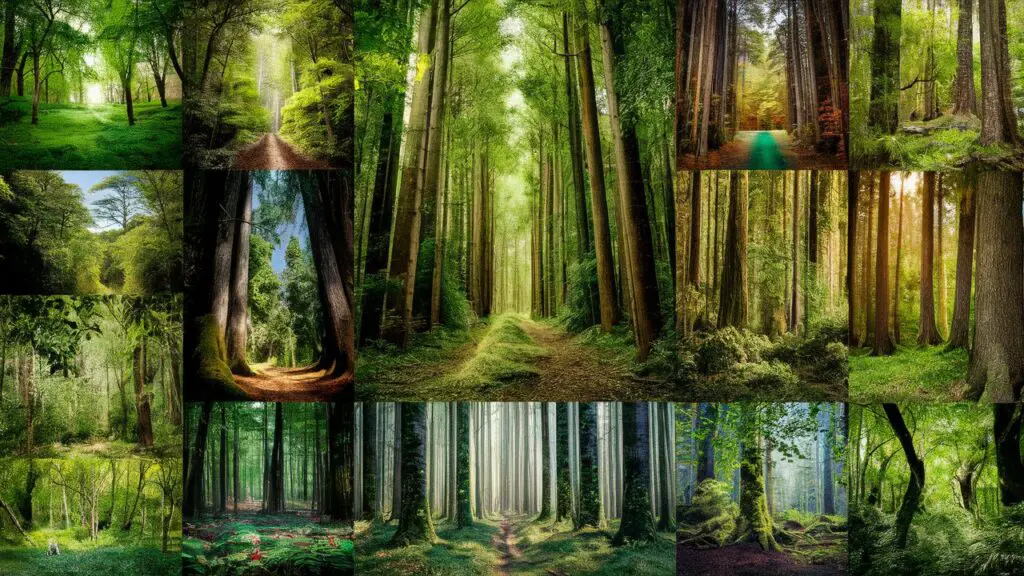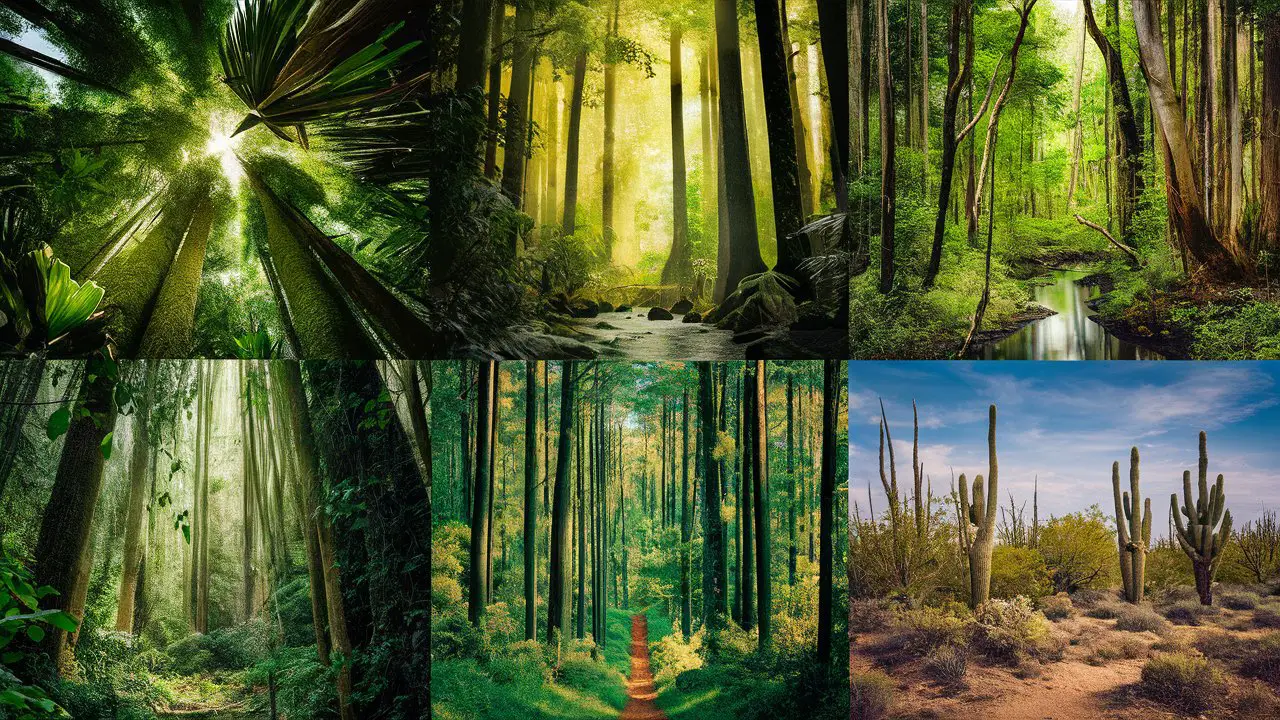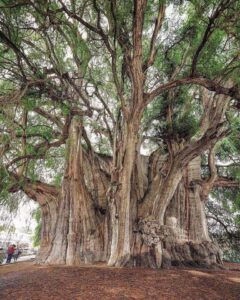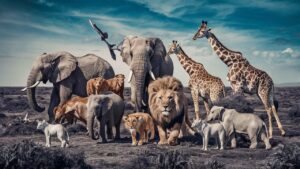As you walk through the woods, you notice the trees around you begin to change. The orderly rows of slender evergreen pines give way to scattered clusters of broadleaf deciduous trees. Their leaves start to turn brilliant shades of red, orange, and yellow as autumn arrives. You have wandered from a coniferous forest into a deciduous one without even realizing it. The transition was so gradual that you did not notice the increasing biodiversity and seasonal variations that distinguish these two major forest types. In your explorations, you will encounter many kinds of forests, each with unique features shaped by climate, soil, wildlife, and human influence. Understanding what defines each distinct forest ecosystem better equips you to appreciate nature’s intricate web of life.
An Overview of Forest Types Around the World
Tropical Rainforests
Tropical rainforests are dense, biodiverse forests located in tropical regions around the equator. They receive high amounts of rainfall and contain millions of plant and animal species. Tropical rainforests produce much of the world’s oxygen and absorb large amounts of carbon dioxide, making them crucial in mitigating climate change. However, many are under threat due to deforestation and habitat loss.
Temperate Forests
Temperate forests have four seasons and consist of both deciduous and coniferous trees. Deciduous forests contain trees such as oak, maple and hickory that shed their leaves seasonally. Coniferous forests are dominated by cone-bearing trees such as pine, fir and spruce that remain green year-round. Temperate forests are found throughout mid-latitude regions of the Northern and Southern Hemispheres.
Boreal Forests
Boreal forests, also known as taiga, are located south of the Arctic circle and north of temperate forests. They are cold and snowy for much of the year. The long, harsh winters and short summers make boreal forests unsuitable for most plant and animal life. However, species such as moose, wolves, bears and owls have adapted to survive in these forests. Dominant trees are cold-tolerant conifers such as spruce, fir, pine and larch. Boreal forests play an important role in the global carbon cycle by absorbing and storing large amounts of carbon.
In summary, the major forest types around the world are tropical rainforests, temperate forests and boreal forests. Although diverse, these forest ecosystems share the common roles of supporting a variety of plant and animal life, regulating the water cycle and mitigating climate change through carbon sequestration and storage. Protecting forests is crucial to ensure the health of our planet.
Deciduous Forests: Trees That Lose Their Leaves
Deciduous forests are home to trees that seasonally shed their leaves. Predominantly located in temperate climates, deciduous forests experience four distinct seasons. In autumn, the green summer canopy transforms into vibrant shades of red, orange and yellow as the leaves prepare to fall.
A Seasonal Cycle
As winter approaches, the bare treetops allow more sunlight to reach the forest floor. Dormant seeds awaken and a variety of woodland flowers bloom. Birds and other wildlife also become more visible and active during this period.
When spring arrives, new leaf buds appear and unfold into fresh green leaves. Photosynthesis resumes, fueling new growth as the forest springs back to life. During the warm summer months, a lush green canopy shields the woodland below. Deciduous trees have broad leaves that capture ample sunlight to support their rapid seasonal growth.
A Diversity of Trees
Deciduous forests are typically dominated by trees such as maple, oak, hickory, chestnut and beech. Maples are prized for their vibrant fall foliage, while oak and hickory produce edible nuts. The American beech has smooth gray bark and oval leaves. The American chestnut was once a key tree in deciduous forests until chestnut blight eliminated most mature specimens in the early 1900s.
With the right seasonal conditions, deciduous forests can support a high diversity of plant and animal life. Their cyclic renewal of growth is a vibrant ecological process that has captivated human imaginations for centuries. For nature enthusiasts, deciduous forests remain an ideal destination any season of the year.
Coniferous Forests: Trees With Needle-Like Leaves
Coniferous forests, also known as taiga, are dominated by cone-bearing trees with needle-like leaves such as pines, spruces, firs, and cedars. These evergreen trees are well adapted to cold climates and short growing seasons.
Adaptations to Cold
Coniferous trees have developed several adaptations to survive freezing temperatures and long, harsh winters. Their narrow, wax-coated needles minimize surface area, reducing water loss. The waxy coating also protects against freezing and wind. Coniferous trees generally have conical shapes that allow snow and ice to slide off easily.
Slow but Steady Growth
While coniferous forests have a short growing season of only a few months, the trees are well suited to a slow but steady growth rate. The trees’ needles stay on year-round, allowing them to photosynthesize whenever conditions permit. The trees also produce wood that is very dense and resinous, allowing them to become very old. Some species like redwoods and sequoias can live for thousands of years.
Unique Ecosystem
The coniferous forest ecosystem is home to animals such as moose, caribou, wolves, lynx, owls, and woodpeckers that are adapted to the harsh, cold climate. The forest floor has little undergrowth due to the dense canopy above and the acidity of the fallen pine needles. However, lichens, mosses, and fungi thrive in the damp, shady conditions. The ecosystems are fragile, however, and are being lost at an alarming rate due to logging and pollution. Protecting these ancient forests is crucial to conserving biodiversity.
Coniferous forests provide habitats for unique plants and animals, protect watersheds, prevent soil erosion, and are an important economic resource. Their slow growth and vulnerability to human activity mean these forests require sustainable management and conservation to persist for generations to come.
Tropical Rainforests: Hot, Humid and Full of Life
Tropical rainforests are dense, hot and humid forests found in tropical regions near the equator. They are home to the vast majority of the world’s plant and animal species.
Climate
Tropical rainforests have a hot and humid climate with consistent rainfall throughout the year. Average temperatures remain around 25°C, and rainforests receive at least 60 to 100 inches of rain per year. The consistent heat and moisture create an environment ideal for plant and animal life.
Flora
Tropical rainforests contain a wide variety of trees that grow very tall to compete for sunlight, such as mahogany, teak, and ebony trees. They have broad leaves to absorb as much sunlight as possible. Rainforests also contain a variety of vines, ferns, epiphytes such as orchids, and fungi. The dense vegetation forms a layered canopy and contains over half of the world’s plant species.
Fauna
Tropical rainforests are home to most of the world’s animal species, especially insects, reptiles, birds, and mammals. Species such as toucans, parrots, frogs, gorillas, jaguars, and anacondas inhabit the rainforest. The constant warmth and abundant food supply allow many animals to remain active year-round. However, many species are endangered due to deforestation and habitat loss.
Tropical rainforests play an integral role in regulating the earth’s climate and water cycle. However, they are under severe threat due to human activity and deforestation from logging, mining, and agriculture. Conservation of these diverse forests is critical to protecting the millions of plant and animal species within them. Overall, tropical rainforests deserve appreciation and protection due to their ecological importance and abundance of life.

Types of Agroforestry Systems for Sustainable Land Use
Agrosilvicultural systems
Agrosilvicultural systems integrate trees with agricultural crops or pastures. Trees are planted in a systematic pattern with agricultural crops like coffee, cocoa or crops. This system helps provide shade for crops, improves soil properties and provides additional products like fuelwood, timber or fruits. Common examples of agrosilvicultural systems include shade-grown coffee, cocoa plantations, and timber tree plantations with agricultural crops during the early years of tree establishment.
Silvopastoral systems
Silvopastoral systems incorporate trees into pastureland or rangeland. Trees are integrated with forage plants and livestock. This system provides shade and shelter for livestock, improves forage production and soil properties. The trees also provide wood products and often fruits. A common example is planting fodder trees in a systematic pattern in pastures. The fodder trees provide pods or leaves that supplement livestock diets, especially in dry seasons.
Home gardens
Home gardens or compound farms are small-scale agroforestry systems that incorporate trees with crops in the homestead. Home gardens aim to meet the subsistence needs of households. They are commonly found in rural areas or on small farms. A variety of crops, fruits, timber and fuelwood trees are integrated often with livestock. Home gardens provide diverse products to meet household food security, nutrition and income. They help buffer households from market fluctuations and crop failures.
Boundary plantations
Boundary plantations incorporate trees planted along the edges or boundaries of agricultural fields. The trees provide shade, reduce wind speed, help improve microclimate and provide wood products. Common examples are planting timber trees, fruit trees or fodder trees along the edges of crop fields or farm boundaries. The trees diversify farm production and generate additional income and products for farmers without competing for land with the main crops.
In summary, agroforestry systems provide an integrated approach to sustainable land management. By combining trees, crops and sometimes livestock, agroforestry helps optimize productivity, profitability and environmental health. The systems discussed help meet both subsistence and commercial needs of land users in an ecologically sustainable manner.
Conclusion
As you have seen, forests across the world can be classified into different types based on factors like climate, geography, and dominant species. From lush tropical rainforests to sparse boreal forests, each ecosystem plays a vital role. Understanding the unique traits and benefits of various forest types allows us to better appreciate nature’s diversity. Looking ahead, a deeper knowledge of forests can guide conservation efforts and responsible land management. Though forests face threats like deforestation, they remain integral to ecological balance and human welfare when properly protected. We all have a part to play as stewards of forests and the invaluable resources they provide. By learning more about forests, we take the first steps on that important journey.
Don’t Miss a Thing! Enhance Your Wildlife Photography with Ultra-X Night Vision Goggles.
GET NOW!






